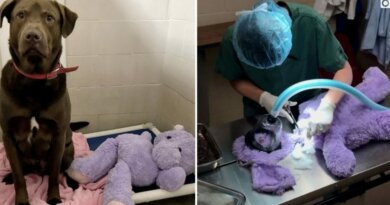New Study Finds 8% of Pet Owners Have Eaten Pet Food – Truth about Pet Food
[ad_1]
Would those 8% eat it IF THEY KNEW what FDA allows it to be made with?
A new pet food study from Purdue University published in the Journal of Food Protection discloses a concerning fact that FDA’s Center for Veterinary Medicine has ignored for decades – putting millions of people at risk.
The study’s focus was on “the potential risk of contracting a foodborne illness from pet food“. Researchers surveyed more than 1,000 pet owners asking pet food handling questions (such as do you wash your hands after feeding your pet?). They learned that most pet owners do not wash their hands after feeding and interacting with their pet, a fact that concerned the researchers. “Feng said the results suggest that pet owners need more education about the safety of pet foods and proper handling of food and pets to prevent contracting an illness.”
There was a clear bias in the study against raw pet food. As example, researchers asked participants what type of pet food they provided their pet. Depending on the style (dry or raw), the follow up questions changed: “If they chose dry pet foods or treats, pet owners were asked where they got it from, how they store it, and how they clean up a food spill. If they selected raw pet foods, owners were asked where they first learned about raw animal food and why they chose that kind of food.”
Pet owners that fed dry/kibble pet foods were not questioned “why they chose that kind of food“, but pet owners that fed raw were.
The biggest issue this study discovered was completely dismissed by the researchers: “8 percent reported eating pet food and treats themselves.”
There are 68 million U.S. households with pets. Eight percent of that 68 million is 5,440,000 people. Per the statistic determined by this study, this means there are 5+ million people that have eaten a pet food or treat.
Now consider this…
U.S. federal law states any food (human or animal food) is adulterated “if it consists in whole or in part of any filthy, putrid, or decomposed substance” and , “if it is, in whole or in part, the product of a diseased animal or of an animal which has died otherwise than by slaughter.”
But, FDA’s Center for Veterinary Medicine (CVM) completely ignores the above federal laws in pet food – directly allowing pet food to contain these illegal ingredients. In April 2019, in response to consumers request for FDA to stop allowing illegal ingredients in pet food, the CVM stated:
“We do not believe that the use of diseased animals or animals that died otherwise than by slaughter to make animal food poses a safety concern and we intend to continue to exercise enforcement discretion where appropriate.”
“Because the rendering and canning processes adequately dealt with any microbiological contamination, FDA concluded that applying enforcement discretion to the use of tissues, including from animals that were diseased or died otherwise than by slaughter, for rendering and canning would not present any food safety concerns.”
Do you think those 5+ million people would have eaten a pet food or treat if they had known it was allowed by FDA to contain a diseased animal or a decomposing animal that died other than by slaughter?
Personal opinion: Absolutely not. Those ingredients in pet food are not disclosed to pet owners because no one would eat a pet food (or buy a pet food) they knew contained illegal ingredients sourced from diseased animals and or decomposing animal material. The FDA allows the pet food industry the opportunity to hide these dangerous, illegal ingredients from consumers in order for billions of pounds of waste to be disposed of each year.
Knowing that University research showed that 8% of pet owners have or will eat their pets food, is FDA being reckless with human health allowing these illegal ingredients in pet food?
Personal opinion: Absolutely yes.
The FDA has no scientific evidence to prove that ingredients sourced from diseased animals or decomposing animals that died other than by slaughter are safe for pets to consume, never the less for people to consume. We filed a Freedom of Information Act request with FDA in 2016 for the science that proves these ingredients are safe for pets. The FDA responded “After searching our files, we did not find the requested records.”
But, there IS significant evidence that proves these illegal ingredients are dangerous for humans. In just one Food Safety Inspection Service document from the USDA – a training document for USDA veterinarians – there is page after page of “Livestock Diseases and Conditions of Public Health Significance“. All of the condemned livestock conditions discussed in this USDA document is allowed into pet food by FDA with no warning or disclosure to the consumer.
The following letter was sent to FDA (9/2/20), attention Dr. Steven Solomon Director of CVM and Dr. Timothy Schell Director of CVM Office of Surveillance and Compliance:
Dear Dr. Solomon and Dr. Schell –
Pet owners concerned with FDA’s allowance of illegal ingredients into pet food with no warning or disclosure would like to bring to your attention a new study from researchers at Purdue University. The study – which can be found here: https://meridian.allenpress.com/jfp/article/doi/10.4315/JFP-20-108/439970/Risk-of-Foodborne-Illness-from-Pet-Food-Assessing – surveyed more than 1,000 pet owners across the United States primarily regarding their safe handling practices of pet food. One significant issue the researchers learned was that 8% of adult pet owners, and 5% of children of pet owners – had consumed their pet’s food or treat.
It is estimated that 68 million homes in the US own a cat or dog. Converting the study data to real life, this means that more than 5 million U.S. adults and more than 3 million U.S. children have consumed pet food.
Knowing this statistic, can the FDA – with clear conscience – continue to “exercise enforcement discretion” allowing pet foods and pet treats to include ingredients that violate federal law sourced from “diseased animals or animals that died otherwise than by slaughter” with no warning or disclosure on the pet food label?
We have exhausted every administrative effort with FDA attempting to protect our pets health – asking FDA again and again to stop allowing illegal ingredients in pet food; FDA has turned a deaf ear to every attempt refusing to enforce the Federal Food Drug and Cosmetic Act with pet food.
In this attempt, we are asking FDA to protect human health. Because FDA is now aware that a recent study confirms 8% of adult pet owners and 5% of children of pet owners have or will consume their pet’s food, FDA must immediately end enforcement discretion allowing these dangerous ingredients in pet foods and treats. Without immediate action, should a child or adult die linked to these ingredients – should a zoonotic disease be spread linked to these ingredients – the sole responsibility of that death or illness will be FDA Center for Veterinary Medicine.
We are unfortunately well aware of FDA ignoring the risk of these ingredients with animal consumption. But is the FDA willing to ‘roll the dice’ with 8% of the US pet owning population too?
I am asking for your response to this email. Will the FDA ignore the human health risk of 8% of 68 million US homes with pets? Or will FDA finally enforce the Federal Food Drug and Cosmetic Act with pet food? At the very least, will FDA promptly implement a required warning label on any pet product that contains condemned animal material, diseased animal material or material from animals that have died other than by slaughter?
Susan Thixton
Representing Concerned Pet Owners
AssociationforTruthinPetFood.com
TruthaboutPetFood.com
When the FDA responds, it will be shared.
Wishing you and your pet(s) the best,
Susan Thixton
Pet Food Safety Advocate
TruthaboutPetFood.com
Association for Truth in Pet Food

Become a member of our pet food consumer Association. Association for Truth in Pet Food is a a stakeholder organization representing the voice of pet food consumers at AAFCO and with FDA. Your membership helps representatives attend meetings and voice consumer concerns with regulatory authorities. Click Here to learn more.
What’s in Your Pet’s Food?
Is your dog or cat eating risk ingredients? Chinese imports? Petsumer Report tells the ‘rest of the story’ on over 5,000 cat foods, dog foods, and pet treats. 30 Day Satisfaction Guarantee. www.PetsumerReport.com
Find Healthy Pet Foods in Your Area Click Here

The 2020 List
Susan’s List of trusted pet foods. Click Here to learn more.
[ad_2]
Source link





de Remeron 30 mg sao para tratar a depressiva.
A Remeron no tratamento do transtorno foi estabelecida em estudos controlados com
2
controllato, Remeron si e dimostrato efficace nel mantenere la con depressivo maggiore fino a 40 settimane
Remeron 30
Baliyants.com – ваш верный источник знаний в области маркентинга. В работе с абсолютно каждым клиентом детально погружаемся в бизнес. Регулярно анализируем данные, чтобы ничего не упустить. Воспользуйтесь нашими услугами! Ищете мотивация в маркетинге? Baliyants.com – здесь представлены уникальные авторские проекты. Они для того созданы, чтобы помочь действенно использовать рекламные кампании, повысить рентабельность ваших маркетинговых усилий и оптимизировать бюджеты. Драгоценность агентства Baliyants – это специалисты. Мы исключительно на результат работаем!
Non-Gamstop casinos are the way to go for no-hassle gaming—sweet!
best casino non gamstop
трансформатор масляный [url=https://svarog.forum24.ru/?1-38-0-00000030-000-0-0/]трансформатор масляный[/url] .
Tiger Fortune’s tiger roars make every win epic. fortune tiger
read what he said https://skymoney.net/
Crime
U.S. charges sibling leaders of ruthless Mexico cartel, offers $8 million reward for information leading to their capture
Updated on: April 16, 2025 / 7:02 AM EDT / CBS/AP
[url=https://kraken2trfqodidvlh4aa337cpzfrhdlfldhve5nf7njhumwr7insta.com]kraken3yvbvzmhytnrnuhsy772i6dfobofu652e27f5hx6y5cpj7rgyd.onion[/url]
Federal authorities said Tuesday that they have indicted the top two leaders of a Mexican drug cartel and are offering up to $8 million rewards for information leading to their capture and conviction.
[url=https://kraken3yvbvzmhytnrnuhsy772i6dfobofu652e27f5hx6y5cpj7rgydonion.net]как зайти на кракен в торе[/url]
Johnny Hurtado Olascoaga and Jose Alfredo Hurtado Olascoaga, are accused of participating in a conspiracy to manufacture cocaine, heroin, methamphetamine and fentanyl and importing and distributing the drugs in the United States, authorities said during a news conference in Atlanta. The newly unsealed three-count indictment was returned by a grand jury in September.
[url=https://kraken2trfqodidvlh4aa337cpzfrhdlfldhve57instad.com]kraken через tor[/url]
The two brothers are the leaders of La Nueva Familia Michoacana, a Mexican cartel that was formally designated by the U.S. government in February as a “foreign terrorist organization,” authorities said.
“If you contribute to the death of Americans by peddling poison into our communities, we will work relentlessly to find you and bring you to justice,” Attorney General Pam Bondi said in a statement.
The State Department is offering up to $5 million for information leading to the arrest and/or conviction of Johnny Hurtado Olascoaga and up to $3 million for information about Jose Alfredo Hurtado Olascoaga, who also goes by the name “The Strawberry.” Both men are believed to be in Mexico, officials said.
Separately the U.S. Treasury announced new sanctions Wednesday against the two men and well as two other alleged leaders of the cartel, which the U.S. designates as a “foreign terrorist organization.”
In addition to drug trafficking, the Familia Michoacana cartel has also engaged in extortions, kidnappings and murders, according to U.S. prosecutors.
ссылка на кракен в тор
https://kraken2trfqodidvlh4a37cpzfrhdlfldhve5nf7njhumwr7instad.com
https://www.recycledin.com.br/group/mysite-200-group/discussion/6321b8aa-1860-496c-b2e9-03320416aee3
страница [url=https://alt-coins.cc]Altcoin обменник[/url]
https://www.ewebdiscussion.com/threads/spiel.236865/
http://dfz.dielre.net/__media__/js/netsoltrademark.php?d=https://t.me/Official_1win_1win/1468